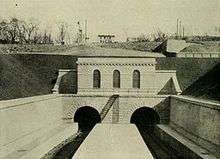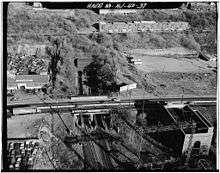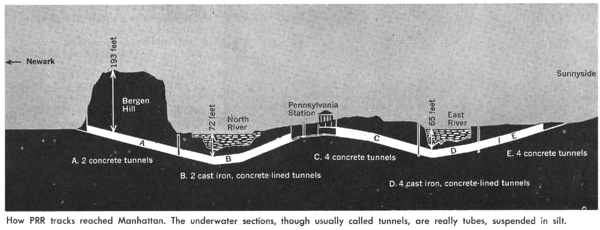New York Tunnel Extension
| New York Tunnel Extension | |||
|---|---|---|---|
 Hackensack portal of the tunnels | |||
| Overview | |||
| Type | Heavy rail, Commuter rail | ||
| System |
Originally Pennsylvania Railroad now Amtrak, New Jersey Transit, Long Island Rail Road. | ||
| Status | In operation | ||
| Locale |
New York City Hudson County, New Jersey | ||
| Operation | |||
| Opened | 1910 | ||
| Owner | Amtrak | ||
| Technical | |||
| Line length | 44 miles (71 km) (total main line trackage) | ||
| Track gauge | 1,435 mm (4 ft 8 1⁄2 in) | ||
| Electrification | 650 V DC third rail (1910-1933). 11,000 V AC overhead lines (1933-present) | ||
| |||
The New York Tunnel Extension (also New York Improvement and Tunnel Extension), was a major project of the Pennsylvania Railroad (PRR) at the beginning of the 20th century, to improve railroad access throughout the greater New York City area. The project comprised tunnels and approaches from New Jersey and Long Island to Midtown Manhattan, leading to the PRR's massive new station, New York Penn Station.[1][2]
History
The PRR had consolidated its control of railroads in New Jersey with the lease of United New Jersey Railroad and Canal Company in 1871, thereby extending its rail network from Philadelphia northward to Jersey City. Crossing the Hudson River, however, remained a major obstacle. To the east, the Long Island Rail Road (LIRR) ended at the East River. In both situations, passengers had to transfer to ferries to Manhattan. This put the PRR at a disadvantage relative to its arch competitor, the New York Central Railroad, which already served Manhattan.[3]
Early tunnel and bridge proposals
Various plans to cross the Hudson were discussed as early as the 1870s, and both tunnel and bridge projects were considered by the railroads and government officials. A tunnel project for the Hudson and Manhattan Railroad (H&M), a rapid transit line, began in 1874, and encountered serious engineering, financial and legal obstacles. The project was halted in 1880 after a blowout accident that cost 20 lives.[4] (Work on the H&M project, known as the Uptown Hudson Tubes, continued intermittently but was not completed until 1908.)
The technology of tunnel-building was still primitive and risky in the 1880s, and this gave impetus to a major bridge design proposal promoted by engineer Gustav Lindenthal.[5]:20 The bridge would be situated between Hoboken, New Jersey and 23rd Street in Manhattan. However, due to the congested shipping conditions in New York Harbor, the design called for an enormous bridge span that would have been twice that of the Brooklyn Bridge. Although Congress granted Lindenthal's company a charter in 1890 for construction of a bridge, the huge $27 million project cost would have to be shared by several railroads.[6] The Panic of 1893 made large capital investments nearly impossible for some time, as one third of the nation's railroads failed.[5]:20 Some foundation masonry was laid on the Hoboken side in 1895, but the PRR was unsuccessful in getting other companies to share in the expenses, and the bridge project was abandoned.[6][7]
Revised plans
The PRR, working with the LIRR, developed several new proposals for improved regional rail access in 1892. They included construction of new tunnels between Jersey City and Manhattan, and possibly a tunnel to Brooklyn; new terminals in mid-town Manhattan for both the PRR and LIRR, completion of the Hudson Tubes, and a bridge proposal. These ideas were discussed extensively for several years but did not come to fruition until the turn of the century. In 1901 the PRR took great interest in a new railroad approach just completed in Paris, France, whereby electric locomotives were substituted for steam locomotives prior to the final approach to the city. This technique enhanced the prospects for building a tunnel under the Hudson. Additionally, the PRR made plans to acquire majority control of the LIRR, so that one new terminal could be built in Manhattan, rather than two.[6]
The PRR created subsidiaries to manage the project. The Pennsylvania, New Jersey and New York Railroad and the Pennsylvania, New York and Long Island Rail Road, were the New Jersey and New York parts, respectively. The PNJ&NY was incorporated February 13, 1902, and the PNY&LI was incorporated April 21, 1902. They were consolidated into the Pennsylvania Tunnel and Terminal Railroad (PT&T) on June 26, 1907.[6]
Design and construction

The design and construction aspects of the project were organized into three principal divisions.
- Meadows Division.The original PRR route in New Jersey ran to the Exchange Place ferry terminal in Jersey City. The Meadows Division project built a new route from the PRR main line at Harrison, New Jersey, northeast to the west end of the new tunnels. This involved constructing a new station at Harrison, Manhattan Transfer, along with a rail yard, to provide for changing between steam and electric locomotives. Northeast from this new station the double track line was built on embankment through the Hackensack Meadowlands to the west portal of the tunnels under Bergen Hill in the Palisades.[8]
- North River Division. The North River Division ran from the west portal of the tunnels to Manhattan. The PRR ultimately decided to build a pair of single-track tunnels under the river, called the North River Tunnels, between Weehawken and mid-town Manhattan; the two tunnels continued seamlessly west from Weehawken to the west portals. In later years "North River Tunnels" came to refer to the whole length of tunnel from the Bergen Hill, or western, portal in North Bergen to 10th Ave in Manhattan. Construction began in 1904 and the tunnels opened in 1910. Penn Station in Manhattan was also completed in 1910 and service from New Jersey to Manhattan began on November 27, 1910.
- East River Division. The East River Division managed construction of tunnels running across Manhattan, and under the East River to a new coach yard in Queens. The East River Tunnels are four single-track tunnels that extend from the eastern end of Pennsylvania Station and cross the East River to Sunnyside Yard. Construction proceeded concurrently with the North River tunnels, and the tunnels opened in 1910. LIRR service to Penn Station began on September 8, 1910.[3]

Operation during the PRR era

The North River Tunnels carried PRR trains under the Hudson; for some years PRR electric engines also pulled Lehigh Valley Railroad or Baltimore and Ohio Railroad trains to New York. The East River Tunnels carried LIRR and (after 1917) New Haven trains, along with PRR trains to the Sunnyside Yard in Queens. All trains were powered by DC third rail until the 1930s, the same third rail system that still powers LIRR trains. In New Jersey the third rail ended at Manhattan Transfer, where all trains stopped to change steam and electric engines.
Until 1961 some PRR suburban trains continued to serve the Exchange Place station, where passengers could board the PRR ferry or the Hudson Tube system (later called Port Authority Trans-Hudson or PATH) to downtown Manhattan. The PRR ended ferry service in 1949.
One branch, the freight-only Harrison Branch, split off the line just east of its west end and ran west to a connection with the Delaware, Lackawanna and Western Railroad's Harrison Cut-off and the Erie Railroad's Paterson and Newark Branch.
Trackage rights
The following non-PRR railroads used the line:
- Baltimore and Ohio Railroad during World War I [9]
- Lehigh Valley Railroad
- New York, New Haven and Hartford Railroad
Operation by successor railroads
The PRR merged into Penn Central Transportation in 1968, and all the property of the PT&T was conveyed to Amtrak on April 1, 1976 when Conrail's system was formed. It is now part of Amtrak's Northeast Corridor; New Jersey Transit and the Long Island Rail Road use their respective halves to reach New York Penn Station.
See also
- Access to the Region's Core – tunnel project, canceled in 2010
- Cross-Harbor Rail Tunnel – project proposed in 1993
- East Side Access – tunnel project, started in 2006
- Gateway Project – project proposed in 2011
- New York Connecting Railroad – follow-up to Tunnel Extension, completed in 1917
- Penn Station Access – proposed project
References
- Notes
- ↑
- Keys, C. M. (July 1910). "Cassatt And His Vision: Half A Billion Dollars Spent In Ten Years To Improve A Single Railroad - The End Of A Forty-Year Effort To Cross The Hudson". The World's Work: A History of Our Time. XX: 13187–13204. Retrieved 2009-07-10.
- ↑ "Nearly Twenty Miles Through Tubes and Tunnels". New York Times. November 9, 1908. Retrieved 2011-02-27.
- 1 2 Schafer, Mike; Brian Solomon (2009) [1997]. Pennsylvania Railroad. Minneapolis, MN: Voyageur Press. pp. 61–64. ISBN 9780760329306. OCLC 234257275.
- ↑ Burr, S.D.V. (1885). Tunneling Under The Hudson River: Being a description of the obstacles encountered, the experience gained, the success achieved, and the plans finally adopted for rapid and economical prosecution of the work. New York: John Wiley and Sons. Retrieved 2011-01-25.
- 1 2 Jonnes, Jill (2007). Conquering Gotham - A Gilded Age Epic: The Construction of Penn Station and its Tunnels. New York: Viking. ISBN 978-0-670-03158-0.
- 1 2 3 4 Couper, William. (1912). History of the Engineering Construction and Equipment of the Pennsylvania Railroad Company's New York Terminal and Approaches. New York: Isaac H. Blanchard Co. pp. 7–16.
- ↑ nycroads.com. "Hudson River Bridge (Unbuilt)." The Crossings of Metro New York. Accessed 2011-01-25.
- ↑ Raymond, Charles W. (September 1910). "The New York Tunnel Extension of the Pennsylvania Railroad.". Transactions of the American Society of Civil Engineers. 68. Paper No. 1150.
- ↑
- Bibliography
- Cudahy, Brian J. (2002). Rails Under the Mighty Hudson (2nd ed.). New York: Fordham University Press. ISBN 0-8232-2190-3. OCLC 48376141.
- Clarke, George C. (September 1910). "The New York Tunnel Extension of the Pennsylvania Railroad. The Site of the Terminal Station". Transactions of the American Society of Civil Engineers. LXVIII.
- Noble, Alfred (September 1910). "The New York Tunnel Extension of the Pennsylvania Railroad. The East River Division". Transactions of the American Society of Civil Engineers. 68. Paper No. 1152.
- Temple, E.B. (September 1910). "The New York Tunnel Extension of the Pennsylvania Railroad. Meadows Division and Harrison Transfer Yard.". Transactions of the American Society of Civil Engineers. 68. Paper No. 1153.
- Lavis, F. (September 1910). "The New York Tunnel Extension of the Pennsylvania Railroad. The Bergen Hill Tunnels.". Transactions of the American Society of Civil Engineers. 68. Paper No. 1154.
- Brace, James H.; Mason, Francis (September 1910). "The New York Tunnel Extension of the Pennsylvania Railroad. The Cross-Town Tunnels.". Transactions of the American Society of Civil Engineers. 68. Paper No. 1158.
- Brace, James H.; Mason, Francis; Woodard, S.H. (September 1910). "The New York Tunnel Extension of the Pennsylvania Railroad. The East River Tunnels". Transactions of the American Society of Civil Engineers. 68. Paper No. 1159.
Coordinates: 40°48′04″N 74°00′47″W / 40.801°N 74.013°W
